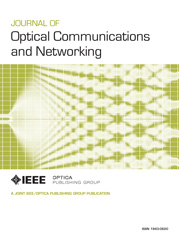JOCN Special Issue on Elastic Optical Networks
Submissions Open: 15 October 2015
Submission Deadline: 30 November 2015
This special edition of JOCN will focus on Elastic Optical Networks. We are targeting the significant amount of recent research into the enabling transponder and switching technologies, coupled with the network benefits in terms of improved spectral efficiency, increased system capacity, and reduced network costs. In scope is the range of data plane enablers for the next generation of flexible optical networks (e.g., flexible ROADMs, DSP, advanced modulation formats, etc.). We anticipate a detailed discussion of bit rate variable transponders and papers addressing the merits and technologies behind the sliceable versions of this novel transponder type with focus on its hardware realization. In this context, power consumption within EONs becomes a particularly important consideration. We also welcome contributions on ROADM architectures for EONs when addressing realistic scenarios and specifications.
Also important is the client-line side interface to enable the full flexibility promised by EONs. This flexibility has to be assessed in a network context, so the call will look specifically for papers seeking to put technology options together with networking benefits (including capacity, economic and energy related). Papers analysing use cases (e.g., multilayer flexrate protection) will add a strong network pull to the edition, and here we invite Service Providers to provide this perspective. Discussions of the evolution of current networks towards EONs is also in scope.
Out of scope is a consideration of control plane issues: this is a data plane focused call with some aspects related to optical networking and network planning.
Although the spatial dimension of flexibility is becoming increasingly important, we are not inviting papers on multi-core/multi-mode fibre technology. However we accept that future networks will have parallel fibre connectivity / SDM of some kind and the impact of this for transponders, switching and networks is addressed as part of this call.
The main objective of this call is to stimulate the discussion on the relative benefits of Elastic Optical Networks as compared to other network architectures, with a clear focus on realistic implementable solutions of the different elements composing next generation optical networks.
Manuscripts must be prepared according to the usual standards for submission to the Journal of Optical Communications and Networking and must be uploaded through OSA's electronic submission system, (/jocn/journal/jocn/author.cfm), specifying from the drop-down menu that the manuscript is for the Feature Issue on Elastic Optical Networks.
Special Issue Editors
Andrew Lord, BT, UK
Antonio Napoli, Coriant, Germany

